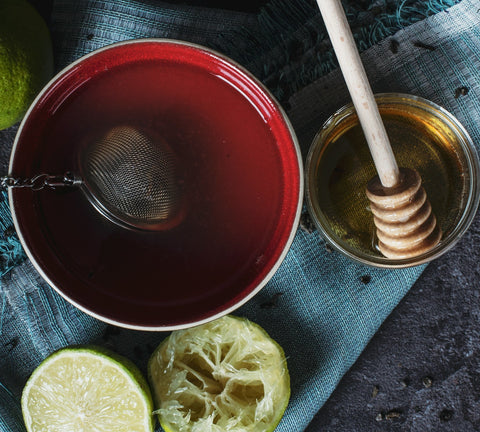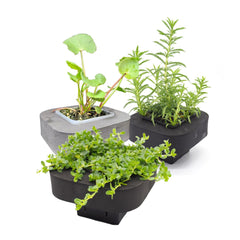Home
>
We Know Water Gardens Blog
>
Grow Your Own Brew: How to Grow Your Own Herbal Tea with Gotu Kola, Brahmi, and Fine Leaf Water Mint Pond Plants
Grow Your Own Brew: How to Grow Your Own Herbal Tea with Gotu Kola, Brahmi, and Fine Leaf Water Mint Pond Plants
on Mar 05, 2024
 According to research conducted by Roy Morgan, half of the Australian population, equivalent to 9.8 million tea drinkers out of a total population of 24.6 million, enjoy a minimum of one cup of tea per week. On average, Australians consume 9.5 cups of tea per person per week, with younger individuals averaging 5.5 cups weekly and those aged 65 and above consuming an average of 10.9 cups per week.
According to research conducted by Roy Morgan, half of the Australian population, equivalent to 9.8 million tea drinkers out of a total population of 24.6 million, enjoy a minimum of one cup of tea per week. On average, Australians consume 9.5 cups of tea per person per week, with younger individuals averaging 5.5 cups weekly and those aged 65 and above consuming an average of 10.9 cups per week.Growing your own herbal tea plants comes with a multitude of benefits. Firstly, it allows you to have complete control over the quality and freshness of your tea. When you grow your own plants, you can ensure that they are grown without the use of harmful pesticides or chemicals, resulting in a healthier and more flavourful tea.
Secondly, growing herbal tea plants is a sustainable and eco-friendly way to enjoy your favourite beverage. By reducing your reliance on store-bought tea bags, you can reduce the packaging waste that accumulates from disposable tea bags. Additionally, growing your own plants helps support biodiversity and creates a haven for beneficial insects and pollinators in your garden.
Lastly, cultivating herbal tea plants can be a rewarding and therapeutic experience, shop our new Pond Plant Starter Pack for Tea Drinkers here , great collection to get you started!. Gardening has been proven to reduce stress and anxiety, and by tending to your plants, you can connect with nature and enjoy the calming effects it brings. The act of growing, nurturing, and harvesting your own tea plants can be a mindful practice that brings you closer to the natural world.
Getting started with growing herbal tea plants
 Before you begin growing your own herbal tea pond plants, it's important to consider a few factors. First, assess the amount of space you have available in your garden. While these plants can be grown in your pond or small patio container, they thrive best when planted directly in the ground. Ensure that the area you choose receives adequate sunlight.
Before you begin growing your own herbal tea pond plants, it's important to consider a few factors. First, assess the amount of space you have available in your garden. While these plants can be grown in your pond or small patio container, they thrive best when planted directly in the ground. Ensure that the area you choose receives adequate sunlight.
Next, familiarise yourself with the climate requirements of the plants you intend to grow. Gotu Kola (Centella asiatica), Brahmi (Bacopa Monnieri), and Fine Leaf Water Mint (Mentha cevina) are generally hardy plants that can tolerate a wide range of climates, but it's important to research the specific needs of each plant to ensure their success in your pond or water garden.
Once you have determined the appropriate location and climate, you can move on to selecting the right plants for your herbal tea garden.
Choosing the right plants for herbal tea - Gotu Kola, Brahmi, and Fine Leaf Water Mint
 Gotu Kola (Centella asiatica) is a perennial herb that is native to wetlands and marshy areas. It is known for its small, rounded leaves and delicate pink or white flowers. Gotu Kola has been used for centuries in traditional medicine for its memory-enhancing properties and is often referred to as the "herb of longevity." In addition to its cognitive benefits, Gotu Kola also has anti-inflammatory and antioxidant properties. Learn more here about this favourite of ours: The Green Wonder: How Growing Gotu Kola in your Pond Can Boost Your Health.
Gotu Kola (Centella asiatica) is a perennial herb that is native to wetlands and marshy areas. It is known for its small, rounded leaves and delicate pink or white flowers. Gotu Kola has been used for centuries in traditional medicine for its memory-enhancing properties and is often referred to as the "herb of longevity." In addition to its cognitive benefits, Gotu Kola also has anti-inflammatory and antioxidant properties. Learn more here about this favourite of ours: The Green Wonder: How Growing Gotu Kola in your Pond Can Boost Your Health.
Brahmi (Bacopa monnieri) is another herb commonly used in herbal teas. It is a creeping plant with small, oblong leaves and white or pale blue flowers. Brahmi has been traditionally used in Ayurvedic medicine to improve cognitive function, reduce anxiety, and promote relaxation. It is also believed to have antioxidant and anti-inflammatory properties, making it a valuable addition to any herbal tea blend.
Learn more about growing Brahmi here: Brahmi: The Herbal Wonder for Boosting Memory and Cognitive Function
Fine Leaf Water Mint (Mentha aquatica) is a freshwater mint that grows along the edges of ponds and streams. It has slender, lance-shaped leaves and produces clusters of small white or pink flowers. Fine Leaf Water Mint has a refreshing minty flavour and aroma, making it a popular choice for herbal teas. It is known for its digestive properties and is often used to soothe an upset stomach or relieve indigestion. Additionally, Fine Leaf Water Mint is rich in vitamins and minerals, making it a nourishing choice for your herbal tea blend. Learn more about growing mint tea pond plants here: Mint Tea: Health benefits & Best varieties to grow
By incorporating Gotu Kola, Brahmi, and Fine Leaf Water Mint into your herbal tea garden, you have a choice of 3 different tea blends that not only taste delicious but also provides a range of health benefits.
Planting and caring for Gotu Kola
Gotu Kola thrives in moist soil and requires partial shade to full sun. 
Gotu Kola will grow well in the pot and floating pond ring in a water feature or pond, this will allow it to grow in any part of your pond regardless of water depth. Additionally, applying a balanced pond plant food every few months can help promote healthy growth.
Gotu Kola is a low-maintenance plant that requires minimal pruning. However, it is important to remove any dead or yellowing leaves to prevent the spread of disease. If you live in a colder climate, you may need to protect the plant from frost by covering it with a frost cloth or bringing it indoors during the winter months.
Planting and caring for Brahmi
 Brahmi is a versatile pond plant that can be grown in both full sun and partial shade. It is suitable for both garden ponds and sealed containers.
Brahmi is a versatile pond plant that can be grown in both full sun and partial shade. It is suitable for both garden ponds and sealed containers.
Brahmi is a relatively low-maintenance plant that requires minimal pruning. However, it is important to remove any dead or yellowing leaves to prevent the spread of disease. Regularly inspect the plants for pests such as aphids or snails and take appropriate measures to control them if necessary. Brahmi will grow well in the pot and floating pond ring in a water feature or pond.
Planting and caring for Fine Leaf Water Mint
Fine Leaf Water Mint is a water-loving plant that thrives in full sun to partial shade. It can be grown directly in the ground along the edges of ponds or in containers filled with water and placed in a sunny spot. We recommend growing this pond plant in the pot and floating pond ring in a water feature or pond.
Fine Leaf Water Mint is a fast-growing plant that may require regular pruning to prevent it from becoming invasive. Trim back the stems regularly to encourage bushier growth and prevent the plant from taking over other areas of your garden. Additionally, remove any dead or yellowing leaves to maintain the plant's health.
Harvesting and drying your herbal tea plants
Once your herbal tea plants have reached maturity, you can start harvesting the leaves for drying or you can use them fresh. Harvesting should be done in the morning, after the dew has dried, to ensure optimal flavour and potency. Using clean and sharp garden shears or scissors, cut the stems just above the leaf nodes, leaving enough foliage on the plant to sustain growth.
To dry the leaves, we recommend drying them in a food dehydrator or alternatively, spread them out in a single layer on a clean and dry surface, such as a drying rack or a piece of muslin cloth. Place them in a well-ventilated area away from direct sunlight. It is important to avoid moisture and humidity during the drying process, as this can lead to mould or spoilage. Allow the leaves to dry completely, which may take several days to a week, depending on the humidity levels in your area.
Once the leaves are dry, store them in airtight containers, such as glass jars or resealable bags, in a cool and dark place. Properly dried and stored herbal tea leaves can retain their flavour and potency for up to a year.
To make a fresh pot of tea using our range of pond plants, follow the process for harvesting the leaves and instead of drying them, simply cut or chop them into your tea strainer or teapot.
Brewing and enjoying your homemade herbal tea
To brew your homemade herbal tea, start by heating water to the desired temperature. Different herbs may require different water temperatures, so refer to the specific instructions for each herb. Generally, herbal teas are brewed with water that is just below boiling point.
Place a teaspoon of dried or fresh herbal tea leaves per person in a tea infuser or a teapot. Pour the hot water over the leaves and let them steep for 5 to 10 minutes. You can adjust the steeping time based on your preference for a stronger or milder flavour.
Once the tea has steeped, remove the leaves and pour the brewed tea into your favorite teacup. You can enjoy it as is or add a touch of honey or lemon for extra flavour. Sit back, relax, and savour the delicious and nourishing cup of herbal tea that you grew with your own hands.
Growing your own herbal tea plants is a rewarding and sustainable way to enjoy the benefits of nature. With the help of Gotu Kola, Brahmi, and Fine Leaf Water Mint, you can create a customised blend that suits your tastes and supports your well-being. From planting to harvesting, the process of growing herbal tea plants allows you to connect with nature and enjoy the therapeutic benefits of gardening. So why wait? Start your own herbal tea garden today and experience the power of nature in every sip.
© We Know Water Gardens 2024
Share

